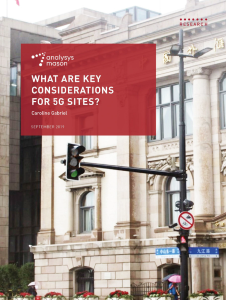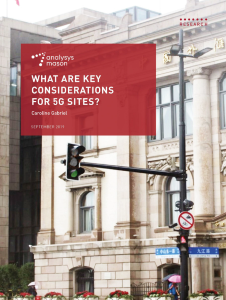What are key considerations for 5G sites?
02 October 2019 | Research
Perspective | PDF (30 pages) | Next-Generation Wireless Networks
 The number of cell sites rises with each generation of mobile technology to support increasing levels of data traffic. This trend will be greatly intensified by the introduction of 5G because of the wide variety of use cases and traffic patterns that will need to be supported, and some of these have demanding requirements for availability and reliability, as well as data rate. 5G use cases, in turn, will rely on a large number of spectrum bands.
The number of cell sites rises with each generation of mobile technology to support increasing levels of data traffic. This trend will be greatly intensified by the introduction of 5G because of the wide variety of use cases and traffic patterns that will need to be supported, and some of these have demanding requirements for availability and reliability, as well as data rate. 5G use cases, in turn, will rely on a large number of spectrum bands.
The requirements for 5G will be fulfilled using new equipment such as Massive MIMO (multiple-input, multiple-output) antennas and mini-macro base stations, which deliver macro cell performance in a compact form factor that can be deployed on, or inside, a pole. Analysys Mason forecasts that by 2025 there will be 14 times more base stations deployed on poles and city furniture than in 2017.
More about this report
These dense networks present significant challenges because of the number of sites that they require. The challenges fall into three main categories:
- total cost of ownership (TCO) as site numbers increase
- operations and maintenance (O&M) for large numbers of base stations
- Challenges with power consumption in dense networks with large antenna arrays.
Zhengmao Li, Executive Vice President of China Mobile, has highlighted the following differences between 5G and LTE, in terms of siting and power consumption:
- 5G needs 300% more base stations for the same level of coverage offered by LTE because of higher spectrum bands
- A 5G site will consume 300% more power than an LTE site and will cost four times more than an LTE one, if they are deployed in the same way.
This white paper examines how operators and other stakeholders will address these challenges in two leading regions for early 5G deployment, Western Europe (WE) and developed Asia–Pacific (DVAP). Dense 5G will only be viable in these regions if costs and power consumption can be greatly reduced, which will mean deploying and managing the sites and their power systems in a completely new way.
If 5G site planning, deployment and management are administered in the same that they were for 4G, Analysys Mason calculates that site costs will increase by 500% by 2023, and energy costs by 900%. This is all happening at a time when mobile network operators (MNOs) want to radically reduce their operating costs (which currently account for almost 70% of TCO). However, new solutions are already starting to emerge as operators in Western Europe and DVAP start to turn on commercial 5G networks. No single solution addresses all the issues of 5G siting, but operators can meet the targets that they have set themselves for TCO reduction, capacity and coverage enhancement and power efficiency if they adopt a combination of new approaches that focus on different aspects of network deployment and operations.

Download
This white paper examines how operators and other stakeholders can address the challenges of early 5G deployment in two leading regions.
Download
Denotes mandatory fieldsAuthors

